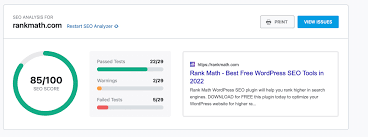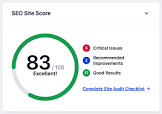Website SEO Analysis: Unlocking the Secrets to Online Success
In today’s digital age, having a strong online presence is crucial for businesses of all sizes. With millions of websites competing for attention, it’s essential to ensure that your website stands out from the crowd. This is where website SEO analysis comes into play.
Search Engine Optimization (SEO) is the process of optimizing your website so that it ranks higher in search engine results pages (SERPs). A comprehensive SEO analysis is like a health check-up for your website, providing valuable insights into its performance and identifying areas for improvement.
So, why is website SEO analysis important?
Enhanced Visibility: By analyzing your website’s SEO, you can identify keywords and phrases that are relevant to your business. Optimizing your content with these keywords helps search engines understand what your website is about and improves its chances of appearing in relevant search results. The higher your visibility in SERPs, the more likely users will find and visit your site.
Improved User Experience: A thorough SEO analysis evaluates various factors that impact user experience on your site. This includes assessing page load speed, mobile responsiveness, navigation structure, and overall usability. By addressing any issues identified through the analysis, you can provide visitors with a seamless browsing experience, encouraging them to stay longer and explore further.
Competitive Edge: Understanding how well your competitors are performing in terms of SEO can give you a competitive advantage. Through an SEO analysis, you can gain insights into their strategies, identify areas where they excel or fall short, and use this information to fine-tune your own optimization efforts.
Targeted Traffic: Effective SEO analysis helps you target the right audience by identifying which keywords and phrases are driving traffic to your site. By focusing on these high-performing keywords and optimizing accordingly, you can attract more qualified leads who are actively searching for products or services like yours.
Conversion Rate Optimization (CRO): An SEO analysis not only focuses on driving traffic but also aims to improve your website’s conversion rate. By analyzing user behavior, identifying potential bottlenecks, and optimizing landing pages, you can increase the likelihood of turning visitors into customers or leads.
Now that we understand the importance of website SEO analysis, what are some key areas to focus on during the analysis?
Keyword Research: Identify relevant keywords and phrases that align with your business and target audience. Use tools like Google Keyword Planner or SEMrush to find popular search terms with manageable competition levels.
On-Page Optimization: Analyze your website’s meta tags, headings, content structure, and internal linking. Optimize these elements by incorporating targeted keywords naturally while ensuring readability and relevance.
Technical SEO: Evaluate technical aspects such as site speed, mobile-friendliness, crawlability, and indexability. Fix any issues that may hinder search engines from properly crawling and indexing your site.
Backlink Analysis: Examine the quality and quantity of backlinks pointing to your site. High-quality backlinks from reputable sources can significantly boost your website’s authority and improve its search rankings.
Content Audit: Assess the quality and relevance of your existing content. Identify opportunities for creating new content that caters to user intent and aligns with popular search queries.
Remember that SEO is an ongoing process, as search engine algorithms evolve continuously. Regularly monitoring and analyzing your website’s SEO performance will help you stay ahead of the curve and maintain a competitive edge in the online landscape.
In conclusion, a thorough SEO analysis is essential for any website looking to succeed in today’s digital world. By understanding how well your site performs in terms of visibility, user experience, competition, targeted traffic, and conversion rates, you can make informed decisions to optimize your online presence effectively.
Investing time and effort into a comprehensive website SEO analysis will undoubtedly pay dividends by driving organic traffic, improving user engagement, and ultimately boosting your online success.
8 Frequently Asked Questions About Website SEO Analysis: A Comprehensive Guide
- What is SEO analysis?
- How does website SEO analysis work?
- What are the benefits of website SEO analysis?
- How do I perform an SEO analysis on my website?
- What tools can I use to analyze my website’s SEO performance?
- How often should I perform an SEO analysis on my website?
- What are the key elements of a successful SEO analysis report?
- What metrics should I consider when evaluating my website’s SEO performance?
What is SEO analysis?
SEO analysis is the process of evaluating and assessing various factors that impact the search engine optimization (SEO) performance of a website. It involves analyzing different elements of a website to identify areas for improvement and develop strategies to enhance its visibility in search engine results pages (SERPs).
During an SEO analysis, several key aspects are typically examined:
- Keyword Analysis: This involves researching and identifying relevant keywords and phrases that users commonly search for in relation to your business or industry. Understanding which keywords are driving traffic and optimizing your website’s content accordingly is crucial for improving its search rankings.
- On-Page Optimization: This aspect focuses on optimizing various on-page elements such as meta tags, headings, URL structure, and content quality. By incorporating targeted keywords naturally into these elements and ensuring they are well-structured, search engines can better understand the relevance of your website’s content.
- Technical SEO: Technical aspects of a website, including site speed, mobile-friendliness, crawlability, and indexability, are assessed during an SEO analysis. Fixing any technical issues that may hinder search engines from properly crawling and indexing your site is essential for optimal visibility.
- Backlink Analysis: Backlinks are links from other websites that point to your site. Analyzing the quality and quantity of backlinks is crucial because high-quality backlinks from reputable sources can significantly improve your website’s authority and boost its search rankings.
- Content Audit: Evaluating the quality, relevance, and uniqueness of the existing content on your website is important for SEO analysis. Identifying opportunities for creating new content that aligns with user intent and popular search queries helps attract targeted traffic.
- Competitor Analysis: Assessing how well your competitors are performing in terms of SEO can provide valuable insights into their strategies and help you identify areas where you can improve or differentiate yourself.
By conducting a comprehensive SEO analysis, businesses can gain a deeper understanding of their website’s current performance and identify specific areas for optimization. This analysis serves as the foundation for developing an effective SEO strategy that aims to increase organic traffic, improve user experience, and boost search engine rankings.
How does website SEO analysis work?
Website SEO analysis involves a systematic evaluation of various factors that impact a website’s search engine optimization. Here’s a breakdown of how it works:
- Keyword Research: The analysis begins with identifying relevant keywords and phrases that are important for your website. This involves researching popular search terms related to your industry, products, or services. Tools like Google Keyword Planner, SEMrush, or Moz Keyword Explorer can assist in finding keywords with high search volume and manageable competition.
- On-Page Optimization: This step focuses on analyzing and optimizing elements within your website’s pages. It includes examining meta tags (title tags, meta descriptions), heading tags (H1-H6), URL structure, and content quality. The goal is to ensure that these elements are optimized with relevant keywords while maintaining readability and relevance.
- Technical SEO Audit: Technical aspects of your website play a crucial role in its performance on search engines. A technical SEO audit involves assessing factors like site speed, mobile-friendliness, crawlability, indexability, XML sitemaps, robots.txt file, and canonicalization. Identifying and fixing any technical issues helps search engines properly crawl and index your site.
- Backlink Analysis: Backlinks are links from other websites that point to yours. Analyzing the quality and quantity of backlinks is an essential part of SEO analysis. Tools like Ahrefs or Majestic can help identify backlinks pointing to your site and evaluate their authority and relevance. High-quality backlinks from reputable sources can boost your website’s authority and improve its search rankings.
- Content Audit: Content is a vital component for both users and search engines. Analyzing the quality, relevance, uniqueness, and engagement level of your content is crucial for SEO analysis. It involves assessing existing content for optimization opportunities as well as identifying gaps where new content can be created to target specific keywords or user intent.
- Competitor Analysis: Understanding how well your competitors are performing in terms of SEO can provide valuable insights. Analyzing their strategies, keywords they rank for, backlinks they have, and content they produce can help you identify areas where you can improve or differentiate yourself.
- Reporting and Recommendations: After conducting the analysis, a comprehensive report is generated, highlighting the findings and recommendations for improvement. The report may include actionable steps to optimize your website’s SEO, such as keyword optimization suggestions, technical fixes, content enhancements, or backlink acquisition strategies.
It’s important to note that SEO analysis is an ongoing process. Search engine algorithms are constantly evolving, and regular monitoring and analysis of your website’s SEO performance are necessary to stay ahead of the competition and adapt to changes in search engine ranking factors.
By conducting a thorough website SEO analysis and implementing the recommended optimizations, you can enhance your website’s visibility, improve user experience, attract targeted traffic, and ultimately achieve better search engine rankings.
What are the benefits of website SEO analysis?
Website SEO analysis offers several benefits that can greatly impact the success of your online presence. Here are some key advantages:
- Enhanced Visibility: SEO analysis helps you understand how well your website is optimized for search engines. By identifying relevant keywords and optimizing your content accordingly, you can improve your website’s visibility in search engine results pages (SERPs). Increased visibility leads to higher organic traffic and more opportunities for user engagement.
- Improved User Experience: A comprehensive SEO analysis evaluates various aspects of your website, including its structure, navigation, page load speed, mobile responsiveness, and overall usability. By addressing any issues identified through the analysis, you can enhance the user experience and keep visitors engaged on your site for longer periods. A positive user experience contributes to better conversion rates and customer satisfaction.
- Competitive Advantage: Analyzing your competitors’ SEO strategies allows you to gain insights into their strengths and weaknesses. By understanding what they are doing well or lacking, you can fine-tune your own optimization efforts to gain a competitive edge. This knowledge enables you to differentiate yourself from the competition and attract more targeted traffic to your website.
- Targeted Traffic: SEO analysis helps you identify which keywords and phrases are driving traffic to your site. By focusing on these high-performing keywords and optimizing your content accordingly, you can attract more qualified leads who are actively searching for products or services like yours. Targeted traffic increases the chances of converting visitors into customers or clients.
- Conversion Rate Optimization (CRO): SEO analysis not only focuses on driving traffic but also aims to improve your website’s conversion rate. By analyzing user behavior, identifying potential bottlenecks in the conversion funnel, and optimizing landing pages, you can increase the likelihood of turning visitors into customers or leads. CRO ensures that your website is not only attracting traffic but also effectively converting it into desired actions.
- Long-Term Success: SEO is an ongoing process that requires continuous monitoring and adjustments. Regularly analyzing your website’s SEO performance allows you to stay updated with search engine algorithm changes and adapt your strategies accordingly. By consistently optimizing your site, you can maintain and improve its visibility, rankings, and overall online success in the long run.
In summary, website SEO analysis provides valuable insights into your website’s performance, enabling you to enhance visibility, improve user experience, gain a competitive advantage, attract targeted traffic, optimize conversion rates, and achieve long-term success in the ever-evolving digital landscape.
How do I perform an SEO analysis on my website?
Performing an SEO analysis on your website can be a complex process, but breaking it down into manageable steps can help you get started. Here’s a general guide on how to perform an SEO analysis:
Keyword Research:
– Identify relevant keywords and phrases related to your business.
– Use keyword research tools like Google Keyword Planner, SEMrush, or Moz’s Keyword Explorer.
– Focus on keywords with high search volume and reasonable competition.
On-Page Optimization:
– Analyze your website’s meta tags (title tags, meta descriptions) and ensure they contain relevant keywords and are compelling for users.
– Review the structure of your URLs and make sure they are concise and descriptive.
– Assess your website’s content for keyword usage, readability, and relevance. Optimize by incorporating targeted keywords naturally.
Technical SEO:
– Check your website’s loading speed using tools like Google PageSpeed Insights or GTmetrix. Optimize images, enable caching, minify code, etc., to improve loading times.
– Ensure that your website is mobile-friendly by using responsive design techniques.
– Verify that search engines can crawl and index your site properly by checking the robots.txt file and XML sitemap.
Backlink Analysis:
– Examine the quality and quantity of backlinks pointing to your site using tools like Ahrefs or Moz.
– Identify toxic or low-quality backlinks that could harm your site’s reputation.
– Focus on acquiring high-quality backlinks from authoritative websites in your industry.
Content Audit:
– Evaluate the quality, relevance, and uniqueness of your existing content.
– Identify gaps in content coverage or opportunities for creating new content that aligns with popular search queries.
– Optimize content by incorporating targeted keywords naturally while ensuring it provides value to users.
User Experience Analysis:
– Assess the overall user experience on your website, including navigation, site structure, and internal linking.
– Ensure that your website is easy to navigate, with clear calls-to-action and intuitive menus.
– Optimize for mobile devices to provide a seamless experience across different screen sizes.
Analytics and Reporting:
– Set up Google Analytics to track website traffic, user behavior, and conversions.
– Regularly monitor key metrics such as organic traffic, bounce rate, average time on page, and conversion rates.
– Generate reports to track progress over time and identify areas for improvement.
Remember that SEO analysis is an ongoing process. Regularly monitor your website’s performance, adapt to algorithm changes, and stay updated with industry best practices. It’s also helpful to seek guidance from SEO experts or use professional SEO tools for a more comprehensive analysis.
What tools can I use to analyze my website’s SEO performance?
There are several tools available that can help you analyze your website’s SEO performance. Here are some popular ones:
- Google Analytics: This is a free tool provided by Google that offers valuable insights into your website’s traffic, user behavior, and conversions. It provides data on organic search traffic, top-performing pages, bounce rates, and more.
- Google Search Console: Another free tool from Google, Search Console allows you to monitor how your website appears in search results. It provides information about indexing status, search queries driving traffic to your site, backlinks, and any issues that may affect your site’s visibility.
- SEMrush: SEMrush is a comprehensive SEO tool that offers a wide range of features for analyzing and improving your website’s performance. It provides keyword research, competitor analysis, backlink analysis, site auditing, and more.
- Moz: Moz offers various tools for SEO analysis. Their Moz Pro suite includes features like keyword research, rank tracking, on-page optimization recommendations, site auditing, and backlink analysis.
- Ahrefs: Ahrefs is a popular SEO tool known for its robust backlink analysis capabilities. It also offers keyword research, competitor analysis, content exploration features, and site auditing.
- Screaming Frog: Screaming Frog is a website crawler that helps identify technical issues on your site that may impact SEO performance. It analyzes factors like broken links, duplicate content, missing meta tags, page speed issues, and more.
- Yoast SEO: If you are using WordPress as your content management system (CMS), the Yoast SEO plugin can be helpful for on-page optimization analysis. It provides recommendations for optimizing individual pages/posts based on target keywords.
These tools vary in terms of features offered and pricing models (some have free versions with limited functionality). Consider your specific needs and budget when choosing the right tool(s) for analyzing your website’s SEO performance. It’s often beneficial to use a combination of tools to gain comprehensive insights into your site’s SEO health.
How often should I perform an SEO analysis on my website?
Performing regular SEO analyses is crucial to maintaining a strong online presence and staying ahead of the competition. The frequency at which you should conduct SEO analyses for your website depends on several factors, including the size and complexity of your site, the level of competition in your industry, and how frequently you update your content. Here are some general guidelines:
- Quarterly Analyses: It is recommended to perform a comprehensive SEO analysis every three months. This allows you to monitor changes in search engine algorithms, track the effectiveness of previous optimization efforts, and make necessary adjustments to your strategy.
- Monthly Check-ups: In addition to quarterly analyses, conducting monthly check-ups can help you stay on top of any immediate issues that may arise. These check-ups can focus on specific aspects like keyword rankings, backlink profiles, or technical SEO elements.
- Post-Content Updates: Whenever you make significant updates or additions to your website’s content, it’s advisable to conduct an SEO analysis shortly afterward. This ensures that the new content is optimized correctly and aligns with your overall SEO strategy.
- Competitor Analysis: Keeping an eye on your competitors’ SEO performance is essential for maintaining a competitive edge. Regularly analyzing their strategies and comparing them with yours can help identify areas where you can improve or capitalize on opportunities.
- Algorithm Updates: Major search engines like Google often roll out algorithm updates that can significantly impact search rankings. When these updates occur, it’s crucial to conduct an immediate analysis to understand how they might affect your website’s visibility and make any necessary adjustments.
Remember that these are general guidelines, and the frequency of SEO analyses may vary depending on your specific circumstances. It’s always better to err on the side of caution and perform more frequent analyses if you have a highly competitive industry or frequently update your website.
By regularly analyzing your website’s SEO performance, you can identify areas for improvement, optimize content effectively, stay updated with algorithm changes, and maintain a strong online presence in the ever-evolving digital landscape.
What are the key elements of a successful SEO analysis report?
A successful SEO analysis report should provide a comprehensive overview of your website’s performance, identify areas for improvement, and offer actionable insights to enhance your SEO strategy. Here are key elements to include in such a report:
- Website Audit: Conduct a thorough audit of your website to assess its overall health. This includes evaluating factors like site structure, URL optimization, meta tags, header tags, internal linking, and site speed.
- Keyword Analysis: Analyze the keywords you are currently targeting and identify new keyword opportunities based on search volume, competition level, and relevance to your business. Include a list of recommended keywords for future optimization efforts.
- Competitor Analysis: Evaluate the SEO strategies of your top competitors. Identify their strengths and weaknesses, including their targeted keywords, backlink profiles, content strategies, and overall online presence. Use this information to refine your own SEO approach.
- Backlink Analysis: Examine the quality and quantity of backlinks pointing to your website. Identify any toxic or spammy links that may be negatively impacting your rankings. Additionally, highlight high-quality backlinks that you can leverage for further optimization.
- Content Assessment: Review the quality and relevance of your existing content. Evaluate factors such as uniqueness, readability, keyword usage, and engagement metrics (e.g., time on page). Recommend improvements or suggest creating new content based on keyword research findings.
- On-Page Optimization: Assess how well your web pages are optimized for targeted keywords. Evaluate elements like title tags, meta descriptions, header tags (H1-H6), image alt tags, and keyword density within content sections.
- Technical SEO Evaluation: Analyze technical aspects that affect search engine crawling and indexing processes. Check for issues like broken links or redirects, XML sitemap errors or omissions, duplicate content problems (canonicalization), mobile-friendliness issues, and site speed optimization opportunities.
- Analytics Review: Study data from tools like Google Analytics to gain insights into website traffic, user behavior, and conversion rates. Identify trends, popular landing pages, and areas for improvement. Use this data to inform your SEO strategy.
- Recommendations: Provide actionable recommendations based on the analysis findings. Prioritize the recommendations based on their potential impact and feasibility of implementation. Include specific steps or guidelines to help you optimize your website effectively.
- Progress Tracking: Set up benchmarks and goals to track the progress of your SEO efforts over time. Include key performance indicators (KPIs) such as organic traffic growth, keyword rankings, backlink acquisition, and improvements in conversion rates.
Remember that an SEO analysis report should be tailored to your specific needs and goals. Regularly reviewing and updating the report will ensure that you stay on top of changes in search engine algorithms and industry best practices, maximizing your website’s visibility and success in organic search results.
What metrics should I consider when evaluating my website’s SEO performance?
When evaluating your website’s SEO performance, there are several key metrics that you should consider. These metrics provide valuable insights into the effectiveness of your SEO efforts and help you identify areas for improvement. Here are some important metrics to consider:
- Organic Traffic: This metric measures the number of visitors that come to your website through organic search results. It indicates how well your website is ranking in search engines and how successful your SEO strategies are in driving traffic.
- Keyword Rankings: Keep track of the keywords you are targeting and monitor their rankings in search engine results pages (SERPs). Improvements in keyword rankings indicate that your optimization efforts are paying off.
- Click-Through Rate (CTR): CTR measures the percentage of users who click on your website’s link when it appears in search results. A higher CTR indicates that your page titles and meta descriptions are compelling, encouraging users to click through to your site.
- Bounce Rate: Bounce rate measures the percentage of visitors who leave your site after viewing only one page. A high bounce rate may indicate that users did not find what they were looking for or had a poor user experience on your site.
- Conversion Rate: Conversion rate tracks the percentage of visitors who complete a desired action, such as making a purchase or filling out a form. It helps evaluate the effectiveness of your website in converting visitors into customers or leads.
- Page Load Speed: Slow-loading pages can negatively impact user experience and SEO performance. Monitor your website’s load speed using tools like Google PageSpeed Insights or GTmetrix and optimize it for faster loading times.
- Backlink Profile: Analyze the quality and quantity of backlinks pointing to your website from other sites. High-quality backlinks from authoritative sources can boost your website’s credibility and improve its search rankings.
- Mobile Responsiveness: With mobile usage on the rise, it is crucial to ensure that your website is mobile-friendly. Monitor your site’s mobile responsiveness and optimize it for a seamless experience on various devices.
- Indexed Pages: Check how many of your website’s pages are indexed by search engines. If a significant number of pages are not indexed, it may indicate issues with crawling or indexing that need to be addressed.
- Social Signals: Assess the engagement and visibility of your website on social media platforms. Likes, shares, comments, and mentions can contribute to increased brand exposure and potential referral traffic.
By regularly monitoring these metrics, you can gauge the effectiveness of your SEO efforts, identify areas for improvement, and make data-driven decisions to optimize your website’s performance in search engine rankings.




